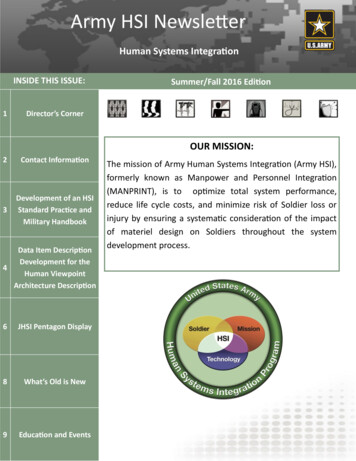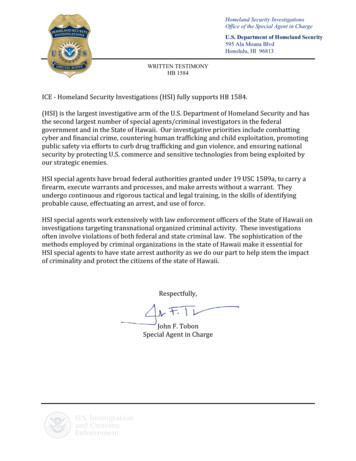
Transcription
Army HSI NewsletterHuman Systems IntegrationINSIDE THIS ISSUE:1Summer/Fall 2016 EditionDirector’s CornerOUR MISSION:2Contact Information3Development of an HSIStandard Practice andMilitary HandbookData Item DescriptionDevelopment for the4Human ViewpointArchitecture Description6JHSI Pentagon Display8What’s Old is New9Education and EventsThe mission of Army Human Systems Integration (Army HSI),formerly known as Manpower and Personnel Integration(MANPRINT), is to optimize total system performance,reduce life cycle costs, and minimize risk of Soldier loss orinjury by ensuring a systematic consideration of the impactof materiel design on Soldiers throughout the systemdevelopment process.
WELCOMEThe Director’s CornerDr. Beverly KnappActing DirectorArmy HSIWelcome to the Army HSI Summer Edition2016. Summer’s about over, but we arecoming to you at the tail end with a fewhot topics.Since February, I have been very proud toserve as the Director (Acting) of the ArmyHSI Office.This year’s spring and summer have beenvery busy for us.One of the most significant areas of endeavor is Joint Service HSI. Joint HSI activity has come to the forefront in a numberof ways. As you will see in this edition ofour newsletter, the Joint HSI WorkingGroup (JHSIWG, an O-6 level forum with allservice representation) launched the initiative to develop an HSI Standard. Mr. OwenSeely from USMC HSI has written an informative piece on the status and excitingway ahead for this effort. It’s a great stepforward for HSI since it will allow specification of HSI work in systems and contractpackages.In conjunction with the HSI standard is awrite-up on an HSI DID (Data Item Description) effort, the Army’s instantiation of theHuman View (HV) Architecture process. Dr.Holly Handley from Old Dominion University has been leading this work in support ofArmy HSI.Days” here in the Pentagon. This was anoverwhelming success and the first timethat the US Coast Guard was able to exhibit HSI excellence with us.Also, the DoDI (Department of DefenseInstruction) 5000.02, Operation of the Defense Acquisition System, dated January07, 2015, is relatively new, and somechanges are being made to update it thisyear. The Joint HSI community is takingthis opportunity to submit changes to thecurrent HSI enclosure (p. 118) of the DoDI5000.02 to strengthen the requirement forHSI in systems – it currently states “TheProgram Manager will ensure that HSI isconsidered at each program milestoneduring the program life cycle” – and mostfolks agree that this can be improved.Bev KnappWe project that our Winter HSI Newsletterwill be at your electronic doorstep beforenext Spring. Until then, HSI Forward!There’s a lot of great Army HSI work nowoccurring. In future HSI Newsletters, I willsolicit short articles to highlight this workand the professionals who are conductingit. In the meantime, I will mention excitingsupport to the DCGS (Distributed CommonGround System) by both the Army andNavy HSI teams, and a spirited effort to getthe DCGS-Air Force folks on board. This is agreat success story that shows how HSI canbe applied to ensure the design of a common user interface experience that crossesservice boundaries and shows some of HSIbest practices at work. A tip of the HSI hatto Diane Quarles (ARL-HRED), Matt Risser(contract support to SPAWAR HSI), and lotsof others on this. More to follow.Finally, our Newsletter has a short pictorialsynopsis of our recent “HSI Display21
CONTACTINFORMATIONARMY HSI DOMAIN CONTACTSHEALTH HAZARDSDr. Timothy KluchinskyManager, Health Hazard Assessment ProgramU.S. Army Public Health Center (APHC), Occupational HealthScience DirectorateATTN: MCHP-PH-HHA/ Dr. Timothy A. Kluchinsky, Jr.5158 Blackhawk Road, Bldg. E1570, Rm OE-201Aberdeen Proving Ground, MD 21010DSN 584.1061, COM 410.436.1061 FAX 410.436.1016Email: timothy.kluchinsky.civ@mail.milMANPOWER, PERSONNEL, TRAINING HUMANFACTORS ENGINEERINGDr. Don Headley, Army Research Laboratory (ARL), HumanResearch & Engineering Directorate (HRED)Bldg. 459, Room 210459 Mulberry Point RdAberdeen Proving Ground, MD 21005-5425COM: 410.278.5919, DSN: 298.5919Email: Donald.b.headley.civ@mail.milSOLDIER SURVIVABILITYMr. Richard Zigler, U.S. Army Research LaboratorySurvivability/Lethality Analysis DirectorateATTN: RDRL-SLB-E, Bldg. 328, Room 112AAberdeen Proving Ground, MD 21005-5068SYSTEM SAFETYDAC Graham Walker, Office of the Chief of Staff, ArmySafety Office;ATTN: DACS-SF, Bldg. 1456, Ft. Belvoir, VA 22060-544,COM 703.697.1322, FAX 703.601.2417,Email: graham.k.walker.civ@mail.milDr. Mike Cupples, U.S. Army System Safetyand Readiness Center; Bldg. 4093, Ft. Rucker, AL 36362COM 334.255.3261, FAX 334.255.9478Email: michael.w.cupples.civ@mail.milARMY HSI NEWSLETTERCONTRACTING RESOURCES GROUP, INC.ATTN: Army HSI PROGRAM1133 Light StreetFederal Hill, MD 21230emilie.c.menefee.ctr@mail.milARMY HSI OFFICE CONTACTSHQDA (DAPE-HSI)300 Army Pentagon, Washington, DC 20301-0300COM: 703.695.5848 FAX: 703.695.6997Dr. Beverly G. Knapp DSN 225.6817 COM 703.695.6817Army HSI Director (Acting)C4ISR & Soldier SystemsBeverly.g.knapp.civ@mail.milMr. L. Taylor Jones III COM 256.382.4700 ext. 103Senior Army HSI AnalystAviation, Missile, & Space Systems; Fires & Ammo SystemsLauris.t.jones2.civ@mail.milDr. John D. Warner DSN 225.5820 COM 703.695.5820Senior Army HSI AnalystProtection, Sustainment & EIS SystemsJohn.d.warner38.civ@mail.milMrs. Lisa F. Peters DSN 225.5848 COM 703.695.5848(Pentagon) FAX 703. 695.6997 (Pentagon)Executive AssistantHSI & Business Transformation Division (BTD)BTD COM 703.545.3616 (Crystal City)Lisa.f.peters.civ@mail.milDIRECTORY OF DESIGN SUPPORT METHODSDefense Technical Information CenterMATRIS DTIC-AM San Diego,NAS North Island, Bldg. 1482, Box 357011San Diego, CA 92135-7011COM 619.545.7384; DSN 735.7384Website: http://www.dtic.mil/matris/POLICYDepartment of the Army, G-1, ATTN: DAPE-HSI300 Army PentagonWashington, DC 20310-0300DSN: 225.585332
DEVELOPMENTMr. Owen SeelyDevelopment of an HSI Standard Practice andMilitary HandbookChair of DOD HSI Standards WGNSWC DahlgrenCurrently there are various resourcesavailable to Program Managers thatprovide guidance for how to implementHuman Systems Integration (HSI) in theirprograms. However, the Department ofDefense (DoD) does not have an HSIentry amongst the catalog of DoD standards and handbooks. The significantramifications of this omission are thatacquisition programs lack a standardpractice to ensure HSI activities are appropriately and consistently implemented across DoD. Furthermore, the currentset of HSI Data Item Descriptions (DIDs)is not sufficient for a contractor to perform the full breadth of HSI analysesand activities.After two years of preparations andanalysis, the Working Group selectedSAE International (G45 HSI Committee)the Working Group selected SAE International (G45 HSI Committee) to develop the DoD HSI Standard Practice withgovernment participation from all theservices. Over the next two years as theHSI Standard Practice is being developed, the DoD HSI Standards WG willalso be developing an accompanyingHSI Military Handbook (MIL-HDBK) andnew HSI DIDs to map to the HSI Standard Practice. While the HIS StandardPractice will discuss the HSI programmatic requirements and process for contractors, the MIL-HDBK will provideguidance to Program Managers on howto use/tailor the HSI Standard and coverunique government HSI tasks.The resulting set of documentation(standard, handbook, and DIDs) willprovide the government and contractorHSI community with a complimentarytool set to implement and execute thebest practices for HSI. For moreinformation or interest in participating,please contact Owen Seely atowen.seely@navy.mil.In 2014, the DoD HSI Standards WorkingGroup was chartered to, 1) review andassess the catalogue of existing standards, 2) revise and or development anHSI Standard Practice and associated HSIHandbook, and 3) revise and developHSI-related DIDs. The Working Groupcompleted a gap analysis in 2015 thatserved as the basis fordocumenting the gap in HSI standards. Following a series of technical decisionmeetings with the Defense StandardsProgram Office (DSPO) and DefenseStandardization Council (DSC), theWorking Group is pursuing the development of a non-government standard(NGS) that will be adopted by the DoDfor use on contracts as a process standard for executing HSI efforts.43
DEVELOPMENTDr. Holly HandleyData Item Description Development for theHuman Viewpoint Architecture DescriptionProfessorOld Dominion UniversityA current effort supporting both Armyand Navy Humans System Integration(HSI) is focusing on developing a DataItem Description (DID) for the HumanViewpoint Architecture Description(HVAD). The Human View provides anintegrated set of models, similar toexisting architecture viewpoints, thatinclude human data as part of thesystem architecture description (NATO,2010). A completed HVAD provides away to include early HSI considerationsinto the mainstream acquisition ,tasks,constraints, metrics, etc. for use inanalysis efforts by both systemengineering and human systemintegration teams. A DID supports thisanalysis by standardizing the collectionand representation of the data. Thecontent and format requirements for aDID is defined within MIL-STD-963C(DoD, 2014). A DID for the Human Viewwill help to formalize the practice ofcompleting the HVAD as part of thearchitecting and engineering processes,and can be used to insure complianceon the delivery, format and content ofthe data.The DID follows a standard format. Thefirst paragraph of the DID indicates theuse of the data:“The Human Viewpoint ArchitectureDescription(HVAD)dataitemdescription (DID) provides the data andrelationships necessary to augment theSystem Architecture Description withinformation on the human component.The HVAD DID contains the set of viewscompleted during the early acquisitionsystem architecting process to capturethe Human System; as used in this DIDthe Human System refers to the set ofpeople who interact with or completefunctions as part of the system. It documents the human focused data requiredto address human-system integration(HSI) concerns that are lacking in otherarchitecture frameworks.”The second section of the DID indicatesthe data’s format. Note that this sectionincludes a reference to DoDAF (2010), asthe purpose of the Human View is toaugment traditional system architectingefforts:“The HVAD DID format shall beconsistent with the Department ofDefenseArchitectureFramework(DODAF). Unless effective presentationwould be degraded, the initial formatshall be used for all subsequentsubmissions.Revisions shall beindicated in a manner consistent withstandard editorial practices.”HVAD. Note that if any of the sectionsbelow is substantially covered inanother document, a summary of thecontent and reference or link to thedocument is sufficient:a. Concept. The contractor shallprovide a description of the context of theHuman System in relation to the environment, operational demands, andtechnical components. The descriptionshall include a textual or pictorialrepresentationofthehumansinteracting with the system, specificinfluences on the human from thesurroundings, events that triggerspecific human activities, and technicalalternatives to be evaluated.b. Constraints. The contractor shallprovide a description of any constraintswhichmayalterthehumanperformance of certain roles or tasks.The description shall identify theconstraint, the specific role(s) or task(s)affected, the HSI domain(s) affected, thelimitation imposed by the constraint,and the impact on human performance.If possible, the source or reference forthe constraint shall be provided.Continued on next page.The last section of the DID describes thecontent specifications of the complete54
DEVELOPMENTData Item Description Development for theHuman Viewpoint Architecture Description.Continued from previous pagec. Tasks. The contractor shall provide adescription of the human-specific tasksto support the overall operational andsystem activities. This description shallinclude a task name; a description of thetask; the relationship of the task withother tasks (either through adecomposition relationship or aprecedencerelationship);specificknowledge, skills, and abilities (KSA)required by the task; and assignment ofthe task to specific roles; and equipmentor software used to perform the task.Exchanged at the nodes; and thesystem technology used to exchange theinformation or data.d. Roles. The contractor shall provide adescription of the personnel jobfunctions or task responsibility areas.This description shall include a rolename; an aggregation of allocated tasks;a job series designator (e.g., rank, rate,militaryoccupationalspecialty);competency or specific knowledge,skills, and abilities (KSA) required; andany specific crew assignment or locationrequirements.g. Metrics. The contractor shall providea description of the measures ofperformance that will be used to evaluate human performance, the attribute(i.e., timeliness) to be evaluated, themeasurement that will be used toevaluate the attribute (i.e., seconds),and the range of acceptable values orlimits (i.e., not greater than 10seconds).”e. Human network. The contractor shallprovide a description of the relationshipbetween roles and tasks based oncommunication patterns, informationflows, or other types of data exchanges.The description shall include the nameof the workflow, process, or team; therole(s) or task(s) depicted at the nodes;the type of interactions between thenodes; the information or dataoverall systems performance byensuring efficient and effective use ofhuman resources within the system,ultimately reducing overall system costs.f. Training. The contractor shall providea description of any training that isrequired to operate, maintain, andsupport the system. The descriptionshall contain a description of the task orequipment to be trained, the method ofthe training (e.g., classroom, on-the-job,embedded), and the training resourcesrequired.The HVAD provides a fully integrated setof products that can be used to communicate the importance of the humanaspect of the architecture and the needfor its use in trade studies and decisionmaking support. A DID will ensure thatthe complete suite of data is capturedto support human focused analyses atthe early stages of system design. Theconsideration of human issues early inthe acquisition phase can enhance65
JHSI EVENT2016 JHSI Pentagon DisplayThe Army HSI Office displayed its capabilities at the annual Joint Service HSI event held over two days at the Pentagon on 3-4 May.The theme of the event was “Human-Machine Teaming.” The Army was joined by the Marines, Air Force, Navy, and Coast Guard.Each service presented interactive displays demonstrating the latest technology focusing on the integration of the “Human Element” in system acquisition resulting in enhanced operational performance, reduced total sustained costs, and increased warfightersurvivability.Pictured above from left to right: Lt Sean Sherman,Mr. Allen Rowe, 1st Lt Daniel NealPictured above: This display is an annual event and eachyear the services focus on a different theme. The themefor 2016 was “Human Machine Teaming.”Pictured above from left to right: Dr. Jock Grynovicki, Mr. Richard Kozycki, Dr.Jeffrey Hansberger, Dr. Laurel Allender, Dr. Christopher Best, Dr. ChristopherGarneau, Dr. Beverly Knapp, Ms. Cheryl Burns76
JHSI EVENT2016 JHSI Pentagon DisplayAmong the many visitors to attend the display were several VIPs from thedifferent services including:LTG James McConville—Deputy Chief of Staff, Army G-1Dr. Bob Steinrauf, SES—Director of Plans and Resources, Army G-1Ms. Dolores Johnson-Davis, SES—ASA M&RA, RepresentativeMs. Kathleen Miller, SES—Assistant Deputy, Army G-3/5/7Mr. Jack Daniels, SES—Director of Finance, Army G-8Mr. Mark Lewis, SES—Chief Management Officer, Secretary of the ArmyDr. Patrick Mason, SES—Director, Human Performance, Training & Biotech,DASD ResearchMs. Kristen Baldwin, SES—Deputy Assistant Secretary of Defense for SystemsEngineering, DASD-SEMr. Robert Gold, SES—Director, Engineering Enterprise, DASD-SEMr. William S. Williford III, Director, Integrated Warfare Systems EngineeringSEA 05H, NAVSEAPictured above from left to right: LTG McConville, Army G-1 with Dr. Knapp, Army G-1, HSIRDML Nancy A. Norton—Director of Warfare Integration for Information Warfare, Deputy Director, Navy, Cybersecurity, OPNAV N2N6FPictured above from left to right: Ms. Dolores Johnson-Davis, ASA-M&RA with Dr. William Evans, ARL-HREDPictured above from left to right: Dr. Knapp with Ms. Kristen Baldwin —Deputy Assistant Secretary of Defense for System Engineering, with Mr.Rob Gold of DASD-SE standing by87
WHAT’S OLD IS NEWAn Occasional Feature:What’s Old is New – An Excerpt from the HSIPast (MANPRINT)98
EDUCATION & EVENTSArmy HSI Practitioner’s CourseTimeLocation9:30-12:00Huntsville, ALPoint of ContactMs. Kelly Hopkins, Army HSI Education Administratorkhopkins@alionscience.com*Classes will be held on select Tuesdays throughout each month in 2016.DAU Course CLE 062, Human Systems Integration— Now listed as a ‘Core Plus’ certification course for:SPRDE-SE level II: 2.aspxSPRDE-PSE level I: .aspxOver 500 military, government, and industry professionals have completed the course in less than one year.Enroll now at: http://www.dau.mil/default.aspxThe Army HSI Newsletter is an official bulletin of the Deputy Chief of Staff, G-1, Department of the Army. The Army Human Systems Integration (HSI) Program (AR 602-2) isa comprehensive management and technical initiative to enhance human performance and reliability during weapons system and equipment design, development, andproduction. Army HSI encompasses seven key domains: manpower, personnel, training, human factors engineering, system safety, health hazards, and soldiersurvivability. The focus of Army HSI is to integrate technology, people, and force structure to meet mission objectives under all environmental conditions at the lowestpossible life-cycle cost. Information contained in this bulletin covers policies, procedures, and other items of interest concerning the HSI Program. Statements and opinionsexpressed are not necessarily those of the Department of the Army. This bulletin is prepared twice yearly under contract for the HSI Directorate, G-1, under the provisionsof AR 25-30 as a functional bulletin.109
current HSI enclosure (p. 118) of the DoDI 5000.02 to strengthen the requirement for HSI in systems - it currently states "The Program Manager will ensure that HSI is considered at each program milestone during the program life cycle" - and most folks agree that this can be improved. There's a lot of great Army HSI work now occurring.










